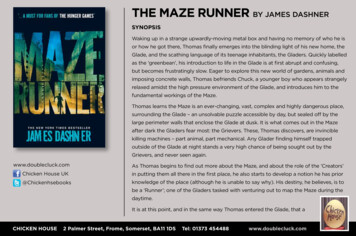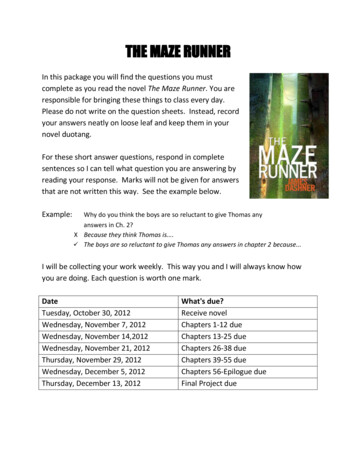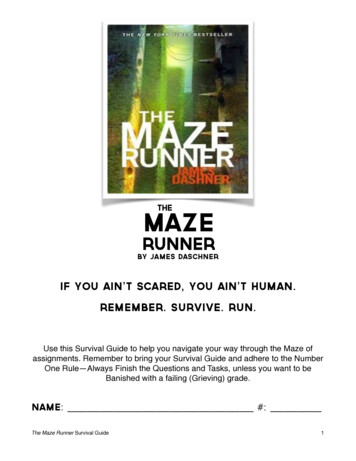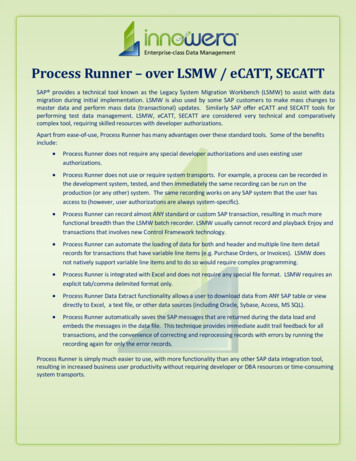
Transcription
THE MAZE RUNNER by James DashnerSynopsisWaking up in a strange upwardly-moving metal box and having no memory of who he isor how he got there, Thomas finally emerges into the blinding light of his new home, theGlade, and the scathing language of its teenage inhabitants, the Gladers. Quickly labelledas the ‘greenbean’, his introduction to life in the Glade is at first abrupt and confusing,but becomes frustratingly slow. Eager to explore this new world of gardens, animals andimposing concrete walls, Thomas befriends Chuck, a younger boy who appears strangelyrelaxed amidst the high pressure environment of the Glade, and introduces him to thefundamental workings of the Maze.Thomas learns the Maze is an ever-changing, vast, complex and highly dangerous place,surrounding the Glade – an unsolvable puzzle accessible by day, but sealed off by thelarge perimeter walls that enclose the Glade at dusk. It is what comes out in the Mazeafter dark the Gladers fear most: the Grievers. These, Thomas discovers, are invinciblekilling machines – part animal, part mechanical. Any Glader finding himself trappedoutside of the Glade at night stands a very high chance of being sought out by theGrievers, and never seen again.www.doublecluck.comAs Thomas begins to find out more about the Maze, and about the role of the ‘Creators’Chicken House UKin putting them all there in the first place, he also starts to develop a notion he has prior@Chickenhsebooksknowledge of the place (although he is unable to say why). His destiny, he believes, is tobe a ‘Runner’; one of the Gladers tasked with venturing out to map the Maze during thedaytime.It is at this point, and in the same way Thomas entered the Glade, that aChicken House2 Palmer Street, Frome, Somerset, BA11 1DSTel: 01373 454488www.doublecluck.com
new Glader appears. Only this time it’s a girl, the first girl to ever enter the Maze, and the last ever person the Creators plan to send in.Teresa (the name we later come to know her by) is discovered, barely conscious, clutching a piece of paper bearing the words, ‘She’sthe last one. Ever.’With time seemingly running out for them, some of the Gladers begin to show animosity towards their two newest members whichclimaxes in one Glader being banished for attempting to kill Thomas. Then, as a result of showing considerable courage and skillduring a night spent outside of the Glade walls, Thomas is promoted to Runner. Under the guidance of Minho, Thomas attempts tomake sense of the Maze and provide the Gladers with a means of escape. But, with Teresa’s words of warning echoing in his head (‘itall has to end soon’), and the Creators’ actions affecting the sanctuary of the Glade, Thomas must work fast to help the Gladers solvethe mystery of the Maze – even if it means risking a fight with the Grievers and confronting his own past What the publisher says .I love books like this. You are plunged into the action, just as confused and frightened as the characters you meet. Thereare no rules – or none that make sense – but gradually you learn to survive, and to hope. Or is that another trick? This isbrilliant, nail-gnashing stuff.Barry Cunningham, Chicken HouseAuthor backgroundJames Dashner, author of The Maze Runner, The Scorch Trials and The Death Cure, was born and raised in Georgiain the United States. After several years working in finance, he decided it was time to pursue his lifelong dream ofbecoming a published children’s author.James is now a full-time writer and lives in the Rocky Mountains with his family.Chicken House2 Palmer Street, Frome, Somerset, BA11 1DSTel: 01373 454488www.doublecluck.com
Author motivation“This first book in the trilogy was heavily inspired by two books I loved as a kid: Ender’s Game and Lord of the Flies. Itwas years in the making, but once I started writing it came together pretty quickly.” James dashner, AuthorTHEMES IdentityFriendshipThe unknownCourageSecretsWRITING STYLEThe Maze Runner is a futuristic dystopian novel for young adults. It is told from the perspective of teenager Thomas,who has no recollection of his previous life; and, as such, the novel is partly a journey of self-discovery. There is also astrong emphasis on notions of friendship, loyalty and courage. The action takes place in a man-made environment (theGlade), from which the characters are trying to escape. The story contains some scenes of horror and violence, withcharacters often finding themselves in perilous situations. 63 chapters, 371 pages, age 12 .pupil activities1: Like the Very First TimeThe Maze Runner begins with Thomas waking up in the ‘Box’, just before he meets the Gladers for the firsttime. What is perhaps most remarkable about this opening chapter is that our learning about world of theMaze is simultaneous with Thomas’s learning. Thomas, like the reader, has no previous experience of theChicken House2 Palmer Street, Frome, Somerset, BA11 1DSTel: 01373 454488www.doublecluck.com
environment being described. This is a useful writing technique, as it affords the reader a detailed account of thesetting – without this description feeling unnecessarily laboured. Also, before we come to understand what the Gladeis from a more objective point of view, we come to know it from a more subjective, experiential one. It is the finedetail that is explored before the bigger picture comes into focus. This is a clever and exciting way to write aboutthe discovery of a new environment, experience, or object; but this technique could also be applied to writing aboutsomething we all probably know quite well. In many ways, this way of writing is like discovering something again forthe first time. Pupils could be tasked with coming up with a similar piece of creative writing – where they are requiredto describe a character’s encounter with something familiar and everyday, but from a purely experiential perspective.In this way, a description of using a toaster could become quite an exciting piece of writing! Pupils could be asked towrite their pieces in as much detail as they can, then swap their writing with other pupils – who must try to discernwhat is being written about.2: Know Your PlaceIn The Maze Runner, all the Gladers have a job to do, each Glader playing a role in maintaining their life in the Gladeand some playing a role in their efforts to escape the Maze. It seems the Gladers’ jobs are distributed according toeach boy’s aptitude for a certain kind of work; those who are athletic become Runners, those who know some firstaid become Med-jacks. Clearly, life in the Glade is built upon each Glader performing an important duty, but arguablysome of these responsibilities are more highly regarded than others. Pupils could be tasked with working in groups toidentify all the different sorts of jobs performed by the Gladers, writing them on cards, and attempting to find a way oforganising them into some sort of order based on importance. This is an interesting activity, as it will encourage pupilsto debate the relative merits of each of the jobs the Gladers are involved in, and will hopefully stimulate a discussion onthe merits of working effectively as a group.3: Crime and PunishmentIn order for the Glade to work successfully, the Gladers must adhere to certain rules, or suffer some severeChicken House2 Palmer Street, Frome, Somerset, BA11 1DSTel: 01373 454488www.doublecluck.com
consequences. For example, the Gladers’ number one rule is that only the Runners may leave the Glade – a ruleThomas breaks in chapter 16. And, after Ben attacks Thomas in the Deadheads, a punishment is meted out in chapter14. In view of this, it would be interesting for pupils, in groups, to decide upon their own set of rules for living in theGlade. It is likely they will need to discuss what they think are the important moral elements to co-existing in thatenvironment, and how best to reaffirm this through law. Some groups of pupils may decide on a long list of rules,some very few (and it might be worthwhile for groups to compare their rules at the end of this activity), but for eachpotential contravention of the rules, groups must also decide on a suitable punishment. These punishments might be‘proportionate’ or disproportionate’, depending on whether they seek to use punishment as retribution or more of adeterrent. Either way, it would provide fuel for a larger class discussion on the nature of crime and punishment, andwhen (if ever) it is acceptable to bend or break the rules.4: RunnersWhen the Runners report back from the Maze at the end of each day, they are required to head straight to the maproom to record their findings. This is vital work in the Gladers’ efforts to escape the Maze. We discover later in the novelthat the maps are instrumental in deciphering a hidden code set out in the landscape of the maze. In the same way,pupils could work in groups to set up their own maze – in separate sections, just like the eight surrounding sectionsof the maze the Gladers investigate. Somehow, across these sections, the group should embed some sort of codeor message; something that would only be decipherable once all the sections were mapped by a visiting group andanalysed together. Each section would need to be designed in some way (pathways, ‘points of interest’ etc.) so that avisiting ‘runner’ could map its essential features. The sections could be as big or as small as space permits (althoughit would perhaps be more worthwhile if a large outside space could be used). Once all the sections were visited andmapped by runners, it would be the task of the visiting group to study these maps, decode them, and follow thehidden message or instructions to claim some sort of prize. This could even be turned into a competition withdifferent groups attempting to beat each other to the prize. Aside from being a fun activity, this task wouldChicken House2 Palmer Street, Frome, Somerset, BA11 1DSTel: 01373 454488www.doublecluck.com
encourage pupils to think about the complexities of both code making and mapping.5: Play the GameIn chapter 37, Thomas tries to convince Newt that the Maze is ‘part of some weird experiment, or test, or somethinglike that’, and that ‘we have to solve it.’ Arguably, once the Gladers start treating the Maze as if it is a kind of game,they learn how they should ‘play’ it. Using The Maze Runner as an example, pupils could be tasked with coming upwith a piece of creative writing, using a game or popular puzzle to influence them. This could act as a major or minorinfluence, but their stories should be built around the idea of there being a problem to solve, or a particular objectiveto fulfil. For example, pupils could use the game of chess as an influence to write a story about the efforts of an armyto capture a king. The influence could perhaps show in a more subtle way than this, with other pupils being asked toguess what game or puzzle the story is based on. For pupils who struggle to come up with ideas for creative writingexercises, this might provide some good starting points.6: Should We Stay or Should We Go?In chapter 53 the Gladers have to decide whether they will carry through the plan to enter the Maze and face theGrievers or stay in the Glade and await their fate. It is literally a life or death decision the Gladers have to make, andone that causes a division in loyalties. Pupils could be asked to assume the position of the Gladers in recreating thismeeting – some pupils arguing for the plan to escape the Maze, others arguing against it. This activity could addresssome of the fundamental questions about the Gladers’ predicament, and whether or not there is anything to be gainedor lost in following either course of action.Writing prompts/discussion questions1. Do you think Thomas was right to break the number one rule and rush to help Alby and Minho in chapter 16?Why?Chicken House2 Palmer Street, Frome, Somerset, BA11 1DSTel: 01373 454488www.doublecluck.com
2. On page 312, Newt tells Thomas, ‘It’s not your fault. You’re a kid.’ Newt here is trying to convince Thomas that heshould not feel guilty for any involvement he might have had in the construction of the Maze. To what extent do youthink the Gladers are responsible for what goes on in the Glade? Is their age a factor in the way you feel about this?Why?3. Is Alby right to want to reject the ‘real’ world, thinking it is worse than life in the Glade? What is your view? Why?4. What do you understand by the term, ‘survival of the fittest’? Could this be linked to The Maze Runner? If so, how?Do you think it is right to be motivated by this?Chicken House2 Palmer Street, Frome, Somerset, BA11 1DSTel: 01373 454488www.doublecluck.com
James Dashner, author of The Maze Runner, The Scorch Trials and The Death Cure, was born and raised in Georgia in the United States. After several years working in finance, he decided it was time to pursue his lifelong dream of becoming a published children's author. James is now a full-time writer and lives in the Rocky Mountains with his .










